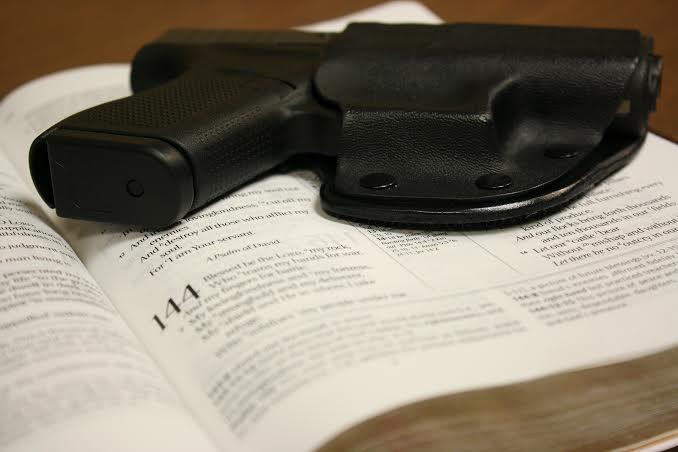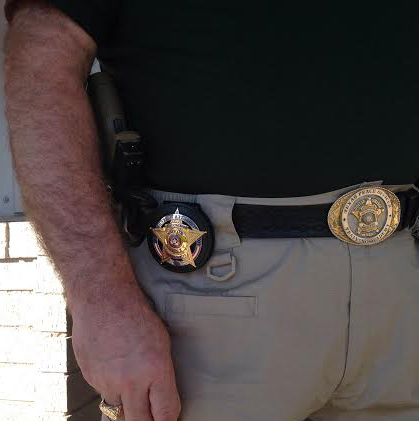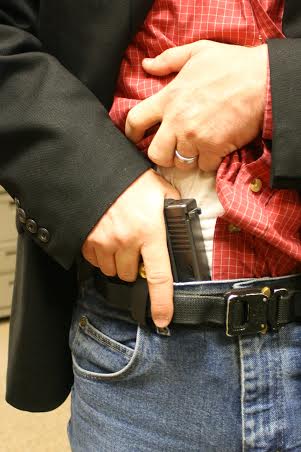
Personal defense inside a church is often an unnecessarily controversial topic. God does not begrudge the church member his or her right to self-defense. See Psalm 144. Photo: author
Deterrence
To potentially deter violent actors, you don’t have to have a big budget. It is very inexpensive to hire an off-duty police officer or an armed security guard to come stand outside the main entrance to the church. An overt security presence might cause a would-be violent actor to think twice before following through with their plan. However, a determined attacker could simply find a way around overt security measures. We have examples such as the Columbine school massacre, where the murderers simply waited for the resource officer to leave his post before beginning their attack. Overt security measures in the form of uniformed officers may provide the psychological “warm and fuzzy” that some people seek when they talk about security, but aside from the possibility of deterrence, there is nothing magical about having one uniformed officer (or ten) on site.

Overt security measures such as off-duty law enforcement officers or armed security guards can help to potentially deter or respond to a violent actor. But they should not be relied upon exclusively, as they can be circumvented. Photo: author
As mentioned above, usually the individuals who approach me are interested in getting volunteers from within the congregation trained and licensed as security officers in order to form a legal church “security team.” Companies will come in and provide the training to help churches get set up with the proper credentials and insurance to make this happen. I would approach this option with extreme caution. Becoming a skilled personal-protection officer is not something you can do as a part-time gig just because you are on the board of deacons. Asking for volunteers will likely invite overzealous individuals, well-meaning though they may be, to bite off more than they can chew.
You don’t want to create a team of poorly trained amateurs and put them in official positions of authority when it comes to security. I have seen several churches do this and have yet to meet an amateur security team that I have confidence in. In my opinion, it is best to leave those services to actual professionals. If you happen to have some of those professionals in your congregation, you have more options, but I would avoid any sort of security team composed of amateurs, even if they are “licensed” amateurs. If you understand the real value of this type of team as discussed in the previous paragraph about overt security in general, you will understand that regardless of whether or not you choose this option, it is not the end-all, be-all.
Detection
With or without overt security, there are several methods we can use to detect potential violence inside a structure. The most efficient method is to control access. Obviously, in a church setting, all are welcome, which means we aren’t likely to have access badges or anything like that for the main service. People can literally come in off the street. That being the case, the best way to control access to the church service is by limiting entry options to monitored access points once the service has begun. If church services begin at a certain time, all side doors that are not monitored should be closed and locked after that time, so people cannot get into the service without someone seeing them.

Controlling access to areas where children are kept, such as nurseries, can aid in detecting unauthorized individuals and preventing them from entering. Options include a locked door and sign-in/out sheet, or electronic devices such as buzzers and access cards. Photo: author
If we make it such that someone is likely to be seen and/or engaged by an usher or someone else when they come through the doors, we have the opportunity to “size them up.” Whoever is handing out bulletins or standing by the door greeting people ought to be looking for obvious cues that an individual could become a problem. While it is true that a crafty individual bent on bringing violence into a house of worship could blend in until they make their move, obvious signs can often be observed simply through basic human interaction. If something about the way a person looks or acts raises a red flag, they can either be denied access or watched more closely once allowed to enter. You have to trust your instincts on this if you perceive something unnerving.
Everyone fixates on the idea of an active shooter coming in and laying waste to the congregation. However, it is far more likely that other less horrifically violent situations could transpire: domestic situations have a tendency to erupt in churches, mentally unstable or inebriated individuals come into services and cause problems, etc. The list of more plausible scenarios goes on and on before you get to the worst-case scenario of a mass murder. Good articles about recognizing pre-attack cues that any vigilant individual can and should read and practice are here on the PDN site. Recognizing the potential for a bad situation before it occurs gives you more options to deal with things before they get out of hand.
Response
When deterrence doesn’t work and the detection strategy either raises significant concerns about an individual or is circumvented, you must be ready to respond. Response can come in several forms. If an individual is found to be a potential problem during the detection process, the response could be asking them to leave and calling the police if they refuse. If an elderly person starts to have a stroke, the response could be rendering aid and calling for an ambulance. That’s one we don’t think about often enough! You are far more likely to encounter a medical emergency than any type of violence inside a church. Do you have a quality aid bag somewhere in the sanctuary? Is there a quick defibrillator in the building and someone on staff trained to use it? Having the ability to respond appropriately to a medical emergency is far more important than the ability to respond to the threat of violence.

Legal concealed carry should be allowed if not encouraged in order to give each individual the ability to defend him or herself in the event that deterrence and detection are not effective. Overt security is only a piece of the response puzzle and should not be viewed as sufficient by itself. The right to carry in a church should not be restricted if it is otherwise legal. Photo: author
There is no way a church can guarantee the security of the congregation with or without a special team, just as there is no way a police force can guarantee the security of the public. It is ultimately the individual’s responsibility to defend him or herself when the chips are down. You can have all the overt security presence you want, but if they aren’t in the right position to take action immediately, the individual will live or die based on their own personal preparedness for the attack.
If churches allow concealed carry, churches can and should offer access to training programs for their members. There are tons of extra-curricular activities that are offered to congregations on a weekly basis. Why not make personal defense training one of them? Churches will likely be able to find trainers who are willing to offer their services at discounted rates or even pro-bono if the church wants to host a class. Doing this would be an easy win-win for the individual armed citizen and the congregation as a whole.
Church Security Conclusion
Churches have numerous affordable options to take advantage of when it comes to security, with the goals of deterrence, detection, and response in mind. Overt measures such as armed security guards and resource officers are inexpensive and can provide a potential deterrent effect as well as a response option. Controlled access and behavioral recognition techniques can help detect potential violence and stop it before it starts. Response can come in many forms, from asking someone to leave, to calling the police, having overt security in the right position to respond, and allowing armed citizens the ability to defend themselves.
In addition, churches can and should encourage armed citizens to train by offering classes from reputable trainers. Approaching security in this manner will be effective regardless of your budget. While volunteer security teams are a possibility, they should be approached with extreme caution from legal, financial liability, and professionalism standpoints. As always, make sure you understand the laws in your state before implementing any of the strategies presented here.
Alot of very good info. There are many things to conserter
Good to know info Would like more. He is the Sheapard, I am the guard dog. Thank ewe. . .
Discounting the value of a highly trained “volunteer” team is a mistake. Our church’s team trains to a standard equal to most paid Law Enforcement. The monthly training includes subjects like emergency first aid, deescalation, communicating with irrational people, recognizing danger, escalation of force, active shooter response and lastly tactical firearms training and testing. The team is made up of active and retired LEOs, military active and retired and highly motivated civilians. All are held to the same high performance standards as active LEOs. A uniformed LEO is on site for most big events if arrest authority is required.
Hi Aaron, I know this article is about 7 years old already. But it certainly is as relevant now, perhaps more so. I have a personal question I'd like to ask you and would appreciate your contacting me. Many thanks.
I am actively involved in educating my fellow Jews on the need to learn responsible firearm use-ESPECIALLY IN THE WAKE OF SO MANY ANTI-SEMITIC ATTACKS ON SYNAGOGUES, JEWISH INSTITUTIONS AND INDIVIDUAL JEWS. PSALM 144:1 IS ON MY CCW HOLSTER.
A lone uniformed security officer can also be overcome simply by shooting him/her first. Then the killer has another gun. Church security should also focus beyond the regular service. The church office may be a target of robbery, and there are other activities like choir practice which occur on a regularly scheduled basis. A person on the local police "frequent flyer" list came to one of our practices looking for a member. We detected him in time to get her out of the way. Several basses and tenors (AKA men) surrounded him and made sure he didn't start trouble until the police could arrive. I was carrying, but stayed in the choir loft so I wouldn't be caught in the middle of things if they went south. The situation was resolved peacefully. Knowing the law is vital. Down here in Texas, you shouldn't have a designated "Church Security" team if anyone is carrying with a license. It can be a "Safety" team, or a "Friendly Greeting" team, but it's an offense to wear anything that gives the impression that members are licensed security or law enforcement officers.
I found this interesting, with solid information, but there is so much more to it than is covered (especially here in CA). I was asked by church leadership to form and organize a security team for my church just over 4 years ago. As a former soldier and contractor, it was believed that I was qualified to do so. My first step was to look at the legality's here in CA. Let me tell you, once I started that part, I no longer felt qualified. It took me a little over 6 months of evenings and a lot of Saturdays to put together a "Policy & Procedures" manual for the team to operate off of. Then, as suggested by the author, I began to hand pick a team, mostly law enforcement and those with prior military service. I then added fireman/EMT's to the team. I formed a 3 tier system. Tier 1 being armed response, Tier 2 being medical and support (are allowed to carry an issued taser after completing proper training), and Tier 3 is mostly "eye's & ear's" but also includes spots for high school youth that have an interest. Everyone must have medical training and "KNOW" California laws on "Citizens Arrest" Tier 1 & 2 have varying levels of advanced training for traumatic injury including gunshot wounds and proper tourniquet use. We use an electronic check-in/out system for children that prints a name tag with bar code for the child, and basically a "claim ticket" for the parent with a matching bar code. All "on-duty" team members have radio's. we also issue radio's to every room that will be used on any given Sunday. This has lead to calls for "Security" to kill a spider or two, but is worth it for the added safety. As the author suggest, once services start, we lock-down the campus so there is only one entry/exit point. We have first aid kits, stop-the-bleed kits, and flex-cuffs strategically placed around campus as well as some carried by team members. We have occasional issues with intoxicated or mentally ill, usually homeless. And upset ex-boyfriend or two. I could go on and on, but I don't want to ramble. The important thing to me and this team, is we are trying to turn this into a ministry. We are using what we know, and what we have learned to help other churches and non-profits access and when needed, set up their own "Safety Team" or program without financial strain of hiring an outside firm to do so. There is a lot of groups and organizations out there that can help with this. But it comes with a price that may, or may not be worth it depending on your churches financial situation. God Bless and stay safe!
Aaron, thank you much for this considerate and valued article. Very well stated.
Any church security person or team should have a liability policy for CCW activity. Such as USCCA, Second Call Defense, etc. Also the church attorney should be involved in the planning and strategy of use for this person or team. A missed shot striking an innocent party will change the picture quickly and I suspect one might find the church backing up saying "We didnt tell him or her to do that." When the legal interrogatories start one of the first questions will be the level of training and who taught the training? Was there discussions on use of force for with the state laws in mind? Who pays for any legal costs in defense of litigation. I have taught NRA CCW for around 12 years. Many church security folks come into class. Most have no legal plan, no litigation coverage, and are acting on their own when they might ever pull the trigger. Many houses of worship hesitate to put any kind of permission to carry and be the s ecurity person or tean in written format. I strongly suggest anyone in this arean contact and attorney and acquire a policy for CCW liability and judgements. Just my humble .02 worth.
Great article. In my experience, a security plan must include the concept of deterrence in-depth. Any security plan with a single point of failure will fail at that point. If you only have a hammer in your tool box, everything becomes a nail. Hiring another individual to watch from an inconspicuous location or watch monitors (with communications to the officer) provides the interlocking fields of view needed to provide the needed redundancy. Vetting for any positions is a must, to include volunteers. Asking to provide proof of proficiency is not asking too much. In addition, insisting that concealed carry individuals check in with the head of security ensures the situational awareness required for a quality security plan. State laws must be considered. It is illegal for concealed carry individuals to carry in church in my state.